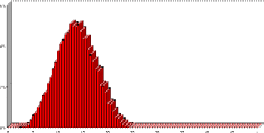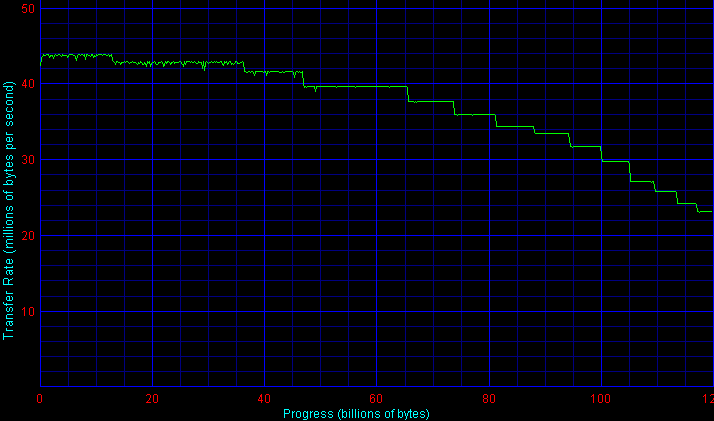|

Capping flagship capacity of the series at 120 gigabytes allows Seagate to offer the drive featuring an unmodified ATA-100 interface. 100 MB/sec of bandwidth is plenty for today’s 7200 RPM (and even 15K RPM for that matter!) drives. The standard ATA-100 unit comes equipped with a 2-megabyte buffer.
It is the upcoming Serial ATA version of the ‘Cuda ATA V that’s captured the fancy of enthusiasts. While the SATA interface itself doesn’t offer performance improvements, Seagate has chosen to couple a larger buffer (8-megabytes) and a lower seek time (9.0 milliseconds) with the SATA connection. As a result, the SATA ‘Cuda will no doubt offer significantly more speed than the standard unit and thus confuse non-SR readers around the globe ;). At this time of this writing, Seagate is still tweaking the SATA version of the drive; the generally available ATA-100 version is the unit reviewed here. We hope to obtain an SATA ‘Cuda as soon as possible.

Now let’s turn to the tests and see how Seagate’s latest stacks up!
Low-Level ResultsFor diagnostic purposes only, StorageReview measures the following low-level parameters: Average Read Access Time– An average of 25,000 random accesses of a single sector each conducted through IPEAK SPT’s AnalyzeDisk suite. The high sample size permits a much more accurate reading than most typical benchmarks deliver and provides an excellent figure with which one may contrast the claimed access time (claimed seek time + the drive spindle speed’s average rotational latency) provided by manufacturers. WB99 Disk/Read Transfer Rate – Begin– The sequential transfer rate attained by the outermost zones in the hard disk. The figure typically represents the highest sustained transfer rate a drive delivers. WB99 Disk/Read Transfer Rate – End– The sequential transfer rate attained by the innermost zones in the hard disk. The figure typically represents the lowest sustained transfer rate a drive delivers. |
For more information, please click here.
|
Note: Scores on top are better. |
|
|||||||||||||||||||||||||||||||||
|
|
||||||||||||||||||||||||||||||||
ST3120023A Average Read Service Time |
ST3120023A Average Write Service Time
|
||||||||||||||||||||||||||||||||
AnalyzeDisk reports a measured average read access time of 13.5 milliseconds, an improvement over the 13.9 ms score turned in by the ‘Cuda ATA IV. Subtracting 4.2 ms to account for the rotational latency of a 7200 RPM spindle speed yields a net measured average seek time of 9.3 milliseconds. The Barracuda ATA V as a result actually beats its published seek time… not bad in this day and age.
Unfortunately, the V seems to regress slightly when it comes to average write access times. Its score of 14.9 milliseconds is significantly higher than the IV’s mark of 14.3 ms.
|
Note: Scores on top are better. |
|
|||||||||||||||||||||||||||||||||
|
|
||||||||||||||||||||||||||||||||
ST3120023A Transfer Rate
|
|||||||||||||||||||||||||||||||||
It appears that the bulk of the ‘Cuda ATA V’s areal density increase was achieved by boosting the number of tracks per inch (how closely the tracks are packed together) rather than the number of sectors per track (which determines how many bytes pass under the read/write heads per disk revolution). The drive tops out with outer-zone transfer rates of 43.8 MB/sec. Though a 4% gain when compared to the IV, the figure still trails older 40/GB platter drives such as the Western Digital WD1200BB and IBM’s Deskstar 120GXP. As we move across zones the transfer rate decays quickly resulting in an inner-zone score for the V that lags its own predecessor by nearly 10%.
Single-User PerformanceStorageReview uses the following tests to assess non-server use: StorageReview.com Office DriveMark 2002– A capture of 30 minutes of actual computer productivity use that exactingly recreates a typical office-style multitasking environment. The applications include: Outlook XP, Word XP, Excel XP, PowerPoint XP, Calypso (a freeware e-mail client), SecureCRT v3.3 (a telnet/SSH client), CuteFTP Pro v1.0 (an FTP/SSH client), ICQ 2000b), Palm Hotsync 4.0, Gravity 2.3 (a Usenet/newsgroups client), PaintShop Pro v7.0, Media Player v8 for the occasional MP3, and Internet Explorer 6.0. StorageReview.com High-End DriveMark 2002– A capture of VeriTest’s Content Creation Winstone 2001 suite. Applications include Adobe Photoshop v5.5, Adobe Premiere v5.1, Macromedia Director v8.0, Macromedia Dreamweaver v3.0, Netscape Navigator v4.73, and Sonic Foundry Sound Forge v4.5. Unlike typical productivity applications, high-end audio- and video- editing programs are run in a more serial and less multitasked manner. The High-End DriveMark includes significantly more sequential transfers and write (as opposed to read) operations. |
StorageReview.com Bootup DriveMark 2002– A capture of the rather unusual Windows XP bootup process. Windows XP’s boot procedure involves significantly different access patterns and queue depths than those found in other disk accesses. This test recreates Windows XP’s bootup from the initial bootstrap load all the way to initialization and loading of the following memory-resident utilities: Dimension4 (a time synchronizer), Norton Antivirus 2002 AutoProtect, Palm Hotsync v4.0, and ICQ 2000b.
StorageReview.com Gaming DriveMark 2002– A weighted average of the disk accesses featured in five popular PC games: Lionhead’s Black & White v1.1, Valve’s Half-Life: Counterstrike v1.3, Blizzard’s Diablo 2: Lord of Destruction v1.09b, Maxis’s The Sims: House Party v1.0, and Epic’s Unreal Tournament v4.36. Games, of course, are not multitasked- all five titles were run in a serial fashion featuring approximately half an hour of play time per game.
For more information, please click here.
|
Note: Scores on top are better. |
The Barracuda ATA V turns in a StorageReview.com Office DriveMark 2002 of 312 I/Os per second. Though a 5% improvement over the marks of the ‘Cuda ATA IV, the score nonetheless trails category leaders from IBM and Western Digital.
Margins increase in the SR High-End DriveMark 2002. The V improves upon the IV by 6% yet lags the Western Digital WD1200BB by over 10%, a perceivable difference in the intensive world of high-end content creation.
SR’s Bootup DriveMark 2002 is an oddball test that measures a drive’s performance in a typical Windows XP boot scenario. It’s odd because it generates queue depths significantly deeper than one would otherwise ever see in single-user operation. Here the ‘Cuda ATA V actually regresses slightly when compared to the IV.
Finally, in the Gaming DriveMark 2002, the status quo returns- The V improves slightly on the IV, but still trails older models from IBM and Western Digital.
Multi-User PerformanceStorageReview uses the following tests to assess server performance: StorageReview.com File Server DriveMark 2002– A mix of synthetically-created reads and writes through IOMeter that attempts to model the heavily random access that a dedicated file server experiences. Individual tests are run under loads with 1 I/O, 4 I/Os, 16 I/Os, and 64 I/Os outstanding. The Server DriveMark is a convenient at-a-glance figure derived from the weighted average of results obtained from the four different loads. StorageReview.com Web Server DriveMark 2002– A mix of synthetically-created reads through IOMeter that attempts to model the heavily random access that a dedicated web server experiences. Individual tests are run under loads with 1 I/O, 4 I/Os, 16 I/Os, and 64 I/Os outstanding. The Server DriveMark is a convenient at-a-glance figure derived from the weighted average of results obtained from the four different loads. For more information click here. |
|
Note: Scores on top are better. |
|
|||||||||||||||||||||||||||||||||
|
|
||||||||||||||||||||||||||||||||
When it comes to budget file-server performance, the Barracuda ATA V, like most other competitors, can’t match Maxtor’s DiamondMax D740X. The D740X’s lower access times allow it to differentiate itself from the competition. When it comes to the more static application of serving unchanging files such as web pages, however, the ‘Cuda ATA V falls into a very narrow range where all ATA drives perform similarly.
Legacy PerformanceeTesting Lab’s WinBench 99 Disk WinMark tests are benchmarks that attempt to measure desktop performance through a rather dated recording of high-level applications. Despite their age, the Disk WinMarks are somewhat of an industry standard. The following results serve only as a reference; SR does not factor them into final judgments and recommends that readers do the same. |
|
Note: Scores on top are better. |
|
|||||||||||||||||||||||||||||||||
|
|
||||||||||||||||||||||||||||||||
Heat and NoiseIdle Noise– The sound pressure emitted from a drive measured at a distance of 18 millimeters. The close-field measurement allows for increased resolution between drive sound pressures and eliminates interactions from outside environmental noise. Note that while the measurement is an A-weighted decibel score that weighs frequencies in proportion to human ear sensitivity, a low score does not necessarily predict whether or not a drive will exhibit a high-pitch whine that some may find intrusive. Conversely, a high score does not necessarily indicate that the drive exhibits an intrusive noise envelope. Net Drive Temperature– The highest temperature recorded from a 16-point sample of a drive’s top plate after it has been under heavy load for 80 minutes. The figures provided are net temperatures representing the difference between the measured drive temperature and ambient temperature. For more information, please click here. |
|
Note: Scores on top are better. |
|
|||||||||||||||||||||||||||||||||
|
|
||||||||||||||||||||||||||||||||
As hard as it is to believe, the Barracuda ATA V improves upon the objectively-measured idle noise floor exhibited by its predecessor by a significant margin. Perhaps mirroring the improvement exhibited between the company’s own Cheetah X15-36LP and Cheetah 15K.3, the ‘Cuda ATA V’s mature FDB motor implementation yields a 3 dB/A reduction when contrasted with the IV. This is the difference between extremely quiet and extremely, extremely quiet. But hey, many enthusiasts relentlessly chew up single digit performance gains, so the ‘Cuda ATA V may well present nirvana for quiet-system fanatics.
Even with Automatic Acoustic Management disabled, the V emits among the quietest seeks one can find in today’s drives.
The ‘Cuda ATA V exhibits a slight increase in operating temperature over the IV, though it’s nothing notable. Seagate’s ATA drives haven’t been among the coolest drives around. Even so, as long as users take care in ensuring adequate ventilation, there’s no need for active cooling.
ConclusionThe ATA-100 Barracuda ATA V is a package that delivers more or less what one would expect from Seagate’s continued evolution of the series. Though it improves slightly upon the performance delivered by the ‘Cuda ATA IV, the V is not a breakneck speed leader. It does, however, combine solid desktop performance (perhaps within a margin of the leaders that is all but unnoticeable) with unbelievably quiet operation. Perhaps the most exciting prospect, however, is the mating of this whisper-quiet functionality with the potentially leading performance of the 8-megabyte SATA version. We can’t wait! |




 Amazon
Amazon